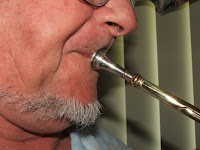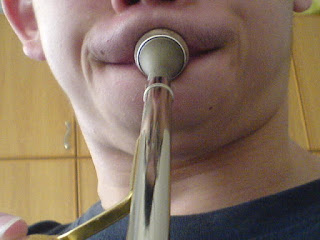When I initially began studying BE, I formed a misconception that I've since observed in other horn players who study BE. I believed that the roll-out (RO) exercises were obviously designed to develop the low register and the high squeaky roll-in (RI) exercises were obviously for developing the upper register. Fortunately for me, I didn't apply this idea to my practice of BE exercises. I worked the whole program and enjoyed very satisfactory results.
The truth is, roll-out and roll-in exercises are designed to develop the embouchure, not a particular register. When the embouchure is developed in a balanced fashion, all registers are improved. RI exercises will improve your upper register, as well as your mid and low registers. RO exercises will improve your low register, as well as your mid and high registers. (Funny how that works!)
The elements of roll-in need to be balanced with the elements of roll-out to develop balance overall.
It's true that some people may benefit more from RO than RI and vice versa, but it may not be obvious exactly what exercises are needed. For me and quite a few others, learning RI seemed like a miracle pill that opened up the upper register. Since I've been working the BE system for 5 years, I now see benefits from practicing RO exercises in myself. I've seen experiences in other horn players that support this as well.
For example, one of my young horn students was struggling with the upper register. After introducing him to Roll-Out #1, he came back one week later thrilled because playing high notes became easier. Jonathan Penny is another who has had unexpected benefits from RO that were not even range related. http://beforhorn.blogspot.com/
Jeff has shared similar stories of RO exercises improving the upper register of trumpeters. Keep in mind, compared to horn players, trumpeters don't even have a low range. Yet, an exercise that appears to a horn player to be designed to develop the low register actually helps trumpeters develop upper range (as well as other aspects of playing).
If you decide you may not need Roll-Out or Roll-In exercises, be aware that you run a risk of missing important elements in the BE system that can help you develop a balanced embouchure.
If you want the maximum benefits of The Balanced Embouchure development system, you need to work the whole program, not just a few exercises.
Lou Denaro has recently been tootling around with the BE exercises. He's found early success with increasing his upper register and recognizes the value of working both extremes. He recently wrote this on the Yahoo Horn:
I think Jeff laid out the book well and users have to work both Roll-Out and Roll-In as Jeff intended and I do believe the overall results in the upper register come from retraining the soft inner lip tissues (roll-out) to work with the harder outer tissues (roll-in). In fact, if you really want to be solution oriented, I suspect that is the whole point of this BE thing.
Some have asked why Jeff Smiley doesn't make public one or two of his BE exercises so people can try them out and see if BE really works. There's a good reason Jeff does not do this. BE is a comprehensive system that is greater than the sum of its parts. One part, one exercise, taken out of context and practiced alone will not yield the desired results that the BE system will.
HOWEVER.... to keep things in perspective, doing the "whole thing" doesn't necessarily mean practicing every exercise every day. Some have found success by rotating and/or alternating the exercises. See Pressed for Time and Practicing BE.












